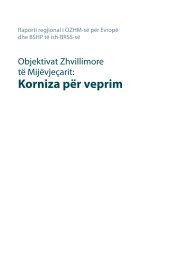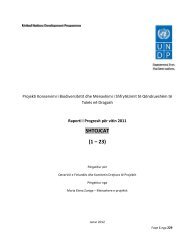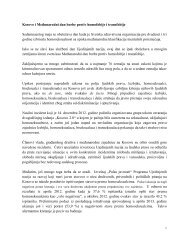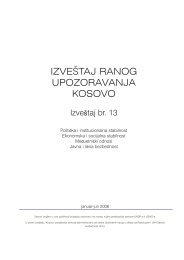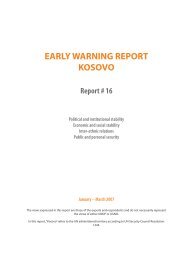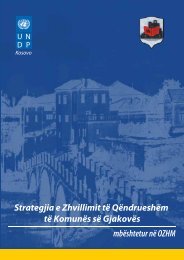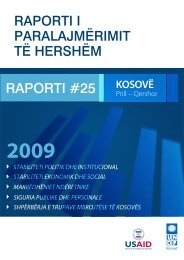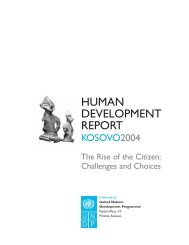Kosovo Human Development Report 2010 - UNDP Kosovo - United ...
Kosovo Human Development Report 2010 - UNDP Kosovo - United ...
Kosovo Human Development Report 2010 - UNDP Kosovo - United ...
You also want an ePaper? Increase the reach of your titles
YUMPU automatically turns print PDFs into web optimized ePapers that Google loves.
strate a wide range of learning needs.<br />
Some may experience difficulties with<br />
reading, writing, or mathematics. Others<br />
may belong to ethnic minorities<br />
and not speak or write well in Albanian.<br />
Others may be from poor households<br />
that have difficulties buying food, footwear<br />
and books. Wheelchair users may<br />
need special physical access to schools<br />
and universities.<br />
The mechanisms that shut many<br />
of these students out of the education<br />
process in <strong>Kosovo</strong> have unique historical/socio-cultural<br />
and governance<br />
roots, namely:<br />
(i) Socio-cultural drivers<br />
• Inter-generational poverty and<br />
unemployment: 48.6 percent of<br />
children 0-19 in <strong>Kosovo</strong> are classified<br />
as poor. 81 As elsewhere, poverty<br />
– itself a product of low education<br />
– makes it very hard for children to<br />
reach the classroom. For those poor<br />
children who do attend, drop-out<br />
rates are higher and learning less<br />
easy. Poor children are excluded in a<br />
number of ways. Their families may<br />
not be able to afford even minimal<br />
outlays for books, clothing and<br />
meals. They may be obliged to work<br />
to supplement low family incomes.<br />
Their nutritional status essential for<br />
brain development and learning<br />
energy is often poorer than that of<br />
their counterparts. Their feelings of<br />
marginalization and relative worthlessness<br />
can make school a painful<br />
experience. Since poverty and lack<br />
of access to factor markets is directly<br />
correlated with education levels,<br />
their parents are unlikely to have<br />
high education standards themselves.<br />
Thus, there is often no role<br />
model in the household to encourage<br />
<strong>Kosovo</strong>’s poor children to acquire<br />
an education. Prioritization of<br />
56 | KOSOVO HUMAN DEVELOPMENT REPORT <strong>2010</strong><br />
education as a factor in household<br />
expenditures is likely to be lower<br />
among poor families. 82<br />
• A historical legacy of exclusion:<br />
<strong>Kosovo</strong>’s legacy of division greatly<br />
complicates the provision of equal<br />
opportunity to all potential students.<br />
83 Organization of a parallel<br />
educational system by the <strong>Kosovo</strong>-<br />
Serb minority after the end of the<br />
armed conflict in <strong>Kosovo</strong>, as a form<br />
of self-exclusion from the formal<br />
educational system of <strong>Kosovo</strong>, is<br />
one of the biggest challenges to<br />
the functioning of an educational<br />
system in <strong>Kosovo</strong> as a whole. At the<br />
same time, this parallel system also<br />
prevents the collection of statistics<br />
on inclusion of the <strong>Kosovo</strong>-Serb<br />
students at all levels of education.<br />
• Low cultural prioritization of early<br />
childhood learning: early childhood<br />
learning has been shown worldwide<br />
to promote higher school attendance<br />
and better quality of education.<br />
However, <strong>Kosovo</strong> has an<br />
alarmingly low rate of pre-school<br />
enrolment. Kindergartens and preschools<br />
are not only not part of the<br />
learning culture, but out of reach<br />
for the most vulnerable and those<br />
least likely to stay in school. Only<br />
5,051 (around 12 percent) of preschool<br />
children were in early learning<br />
in 2006-2007. 84 Children residing<br />
in rural areas often do not have<br />
access to preschool education programmes<br />
at all which negatively<br />
affects their early learning. 85 While<br />
98.2 percent of children included<br />
in the preschool institutions are<br />
<strong>Kosovo</strong>-Albanians, only 1.7 percent<br />
are from other ethnic groups. In<br />
smaller municipalities (Malishevë/<br />
Malisevo, Dragash/Dragas, Junik,<br />
and Mamusha), there are no children<br />
reported to be enrolled in<br />
preschool institutions.<br />
• Discrimination in a vacuum of<br />
social cohesion: above all, inclu-



